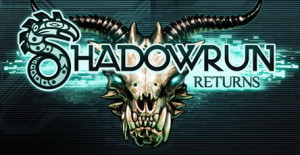Developer: Harebrained Schemes
Where to get it: Steam (for PC and Mac), App Store (for iOS tablets), Google Play (for Android tablets)
Price: $19.99 (PC and Mac, includes mod support), $9.99 (iOS and Android)
GAME GRADE: B+
It’s always popular to talk about how games were supposedly better back in the old days: stories were stronger, gameplay was more complex, the difficulty was more unforgiving, etc. Most of the time, this conversation is just nostalgia, but “Shadowrun Returns” from developer Harebrained Schemes offers a tantalizing taste of the past mixed with a bit of modernity to make you think that yes, some things may have been better back then.
The “Shadowrun” series began as a tabletop pen & paper role playing game, but most gamers probably recognize it from the SNES and Genesis console RPGs released in the ‘90s. “Shadowrun Returns” cuts a similar profile to those games, being an isometric RPG played on a grid. Also intact are the standard RPG mainstays like inventory management, character progression, and dialogue trees; though these are less blasts from the pasts than they are ever-present genre mechanics that have simply been given the retro touch. The strength of the game lies in this: “Shadowrun Returns” is a great example of how to combine old-style gaming themes with modern sensibilities.

Taking place in a 2050’s vision of Seattle, the game exudes a cyberpunk aesthetic that’s somewhere between “Bladerunner” and the “Deus Ex” games (which “Shadowrun” predates). Streets are dark, dirty and cramped, crime and police corruption are rampant, and the sun never shines, typical of Seattle. High-tech toys are everywhere and vast multinational corporations run the show. On top of the traditional cyberpunk setting, “Shadowrun” has the added wrinkle of throwing high fantasy into the mix: Magic exists alongside cybernetics, mystical creatures vie for power alongside criminals and executives. If the general feel is cyberpunk, think of this as injecting a bit of Tolkien with some “Dresden Files” thrown in for good measure. The setting is incredibly well realized and forms the basis of a strong and immersive experience complemented by a strongly-written story.
The main story (the “Dead Man’s Switch” campaign) isn’t as much of a mishmash of genres as the setting premise, at least at first, which works to its advantage. Taking the role of a currently unemployed corporate mercenary (called “Shadowrunners” in this setting), players begin the story investigating the murder of an old associate, whose killing appears to be connected to a string of similar murders in Seattle. It’s a good hook, and the film noir-esque murder mystery provides a great down to earth way to introduce new players to the setting, giving them an everyman’s view of the world and allowing the fantastic elements of the setting to be introduced in a way that feels natural, not overwhelming.

The story, without spoiling too much, eventually moves beyond the murder investigation into a conspiracy/espionage thriller story and works in some elements of a heroic fantasy quest (with a dash of cosmic horror on the side). The narrative remains consistently interesting and engaging throughout, helped by a strong script, a colorful cast of characters (including a couple of cameos from the larger “Shadowrun” setting) and tight pacing.
My main complaint against the story is that it’s too short; the game can be completed in under 10 hours without much rushing, and you will be wanting to experience more when you finally reach the end.
The story’s short length also leads to another problem; there’s not a lot to do outside of the main plot. There are a few optional missions scattered throughout the campaign, and many missions have multiple ways that they can be accomplished, but by and large the story is a linear experience.
Equipment and ability upgrades are also similarly linear in progression: generally speaking, you’ll find that even when you have access to new gear to buy, there’s not much that’s functionally different from your current loadout, though the stats are a little better. There’s more choice in items and abilities as the game progresses, but early on it’s just straight upgrades. Thankfully the gameplay offers more variety than the gear.
“Shadowrun Returns” boasts impressively robust character creation and combat mechanics, doubly impressive considering that the entire game can be played with nothing more than the left mouse button or a touchscreen. Character creation gives the player access to a diverse but not very expansive set of character portraits and cosmetic customization options. While gender and appearance have no bearing on gameplay, race does, as it affects how high certain abilities can be leveled. There’s a large and interconnected set of skill trees to determine how a character actually plays, which when coupled with the fact character classes act more as pre-made suggestions rather than constrained progression paths, allow any player to build a character that perfectly suits their playstyle. Magic-wielding gunmen, well-spoken modern samurai and quick-footed tech experts are all possible, and characters can be anything in between. This is a rare thing nowadays, as most modern RPGs confine players to a single area of character progression or simply make it a non-issue by giving the player character the ability to be good at everything.

Combat in “Shadowrun Returns” is a pleasant surprise, successfully merging the old grid based turn-by-turn tactics of ‘90s RPGs with a modern feel. To do this, it borrows liberally from another favorite of the ‘90s that has recently been reborn in the modern age: “X-COM.”
Last year’s “XCOM: Enemy Unknown” was a great game that managed to morph the arcane and cumbersome rules of its ‘90s incarnation into a simple, intuitive system that “Shadowrun Returns” gleefully cribs from. Considering how good “Enemy Unknown” was, this is by no means a bad thing. Like in “XCOM”, combat consists of controlling a small number of characters (generally the player character, a plot-important character, and hired help) who each have two points to use on their group’s turn. Points are used to move, attack or perform other actions, and enemies play by the same rules; so planning for your enemy’s actions as well as making your own moves is a critical component. Adding to this are wrinkles such as cover for your characters, special actions, managing resources and ammunition and abilities that add or remove action points (which changes the pace of combat drastically). All in all, it’s an extremely fun combat experience with just the right amount of complexity.

There is one major problem with “Shadowrun Returns”, a problem that seems like it came straight from the old days of gaming: its save system. Each character that you create represents a single save file, which is controlled completely by an autosave function, meaning that there is no input on the player’s part on when the game saves your progress. This can be incredibly annoying, as it prevents having multiple saves (pretty much a requirement for an RPG) and because the amount of game time between save points can be quite long in some cases. It is very frustrating to fight through an entire area, only to bite it at the last moment and be forced to do the whole thing all over again. This is a big issue, but it’s mitigated somewhat by the fact that the game is otherwise so engaging that you might not mind having to experience parts a second time.
There’s a few extra bonuses that “Shadowrun Returns” has to assuage the shortness of the main campaign. First among them are the plans of the developer, Harebrained Schemes, to improve the game with additional downloadable campaigns as time goes on. The first of these is scheduled to be released in early 2014. The second is the integrated mod support offered by Steam, which allows players to download fan-made campaigns to play through (only available on the PC and Mac versions of the game). These fan campaigns, made through a free modding kit available from the developer’s site, are simple to install and can add hours of gameplay.
With all this in mind, coupled with the game’s strengths, “Shadowrun Returns” rises above its length and save flaws to be a truly great example of old and new working in harmony.
“Shadowrun Returns” gets a B+ in my book. Well worth the price of admission.








